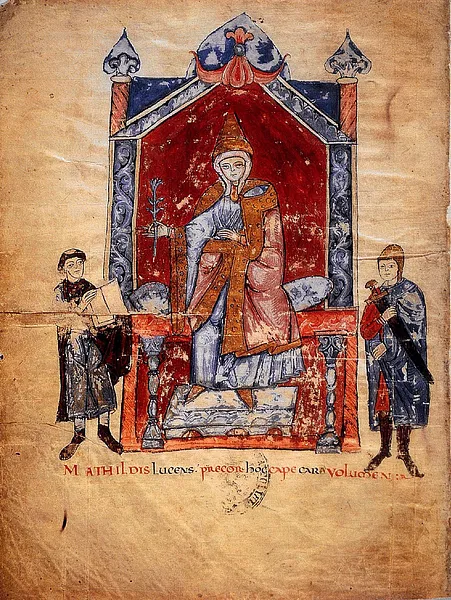From World History Encyclopedia:
Matilda of Canossa (c. 1046-1115), the Countess of Tuscany (r. 1055-1115) and Vice-Queen of Italy (r. 1111-1115), was the final head of the noble House of Canossa following the deaths of her father in 1052 and her elder brother in 1055. One of the most influential women of medieval Europe, Matilda is noted for her military and political prowess, her ceaseless patronage of the Christian Church, and her defense of Papal authority. Though a vassal of the Holy Roman Empire, Matilda often acted independently. Her conflict with the imperial state included a nearly lifelong military conflict with Henry IV (1050-1106), the German king (r. 1056-1105) and Holy Roman Emperor (r. 1084-1105).
Most of Matilda’s holdings, including her family’s ancestral castle of Canossa, were located across the plains of the Po Valley in northern Italy, an invaluable intersection of trade routes between the Italian peninsula and Italy’s northern neighbors beyond the Alps. In the southern part of Matilda domain beyond the Po Valley was the Duchy of Tuscany, rugged with mountains in its north, rural hills throughout, and vital roads connecting to Rome. With these possessions and an impenetrable alliance with the Christian Church, she became an influential political figure in medieval Europe. Matilda was often referred to as the Great Countess (la Gran Contessa) by contemporaries and scholars, despite this title being lesser than her truer title, that of the Margravine of Tuscany. Although she was considered the rightful heir to her father’s northern Italian holdings, Henry IV never recognized her claims to the lands within the Holy Roman Empire.
Matilda was a descendent of the House of Canossa, a noble family established by her great-grandfather Atto Adalbert of Lucca (d. 988), a 10th-century Lombard military leader from Lucca and vassal to the German kings of Italy. Adalbert and his son Boniface expanded their domain and by 1027, the Canossa family's influence encompassed the counties of Brescia, Cremona, Ferrara, Mantua, Modena, Reggio Emilia, and Veneto. In 1027, Roman Emperor Conrad II (r. 1027-1039) transferred the Duchy of Tuscany to Boniface. As Schevill explained,
With Tuscany added to his strength ... Boniface completely dominated central and northern Italy; and since he clung to his superior, the emperor, with more consistency than was usual among feudal magnates, he served as the main pivot of the imperial power in Italy in his day. (53)
In 1037, Boniface married Beatrice of Lorraine (c. 1020-1076), a direct descendent of Charlemagne and Conrad’s niece by way of marriage. Matilda was born to Boniface and Beatrice in 1046 after two older siblings: Frederick and Beatrice. Matilda’s place of birth has been disputed, though scholars have suggested Canossa, Lucca, and Mantua. On 6 May 1052, when Matilda was six years old, Boniface was killed by an unknown assailant, likely by an assassin of Holy Roman Emperor Henry III (r. 1046-1056). Frederick inherited the feudal land of their father while Beatrice governed on his behalf. Matilda’s older sister died shortly after Boniface in 1053, though details are unclear. (Read more.)


















No comments:
Post a Comment